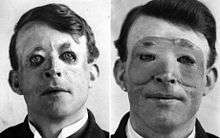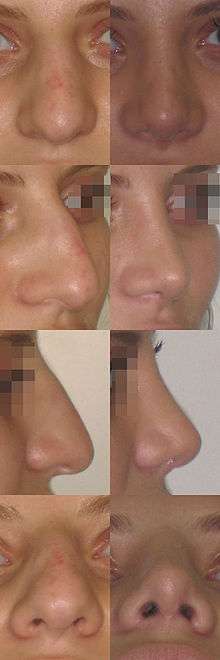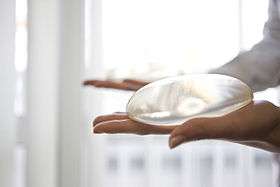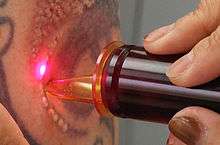Cosmetic surgery in Australia
Cosmetic surgery, also referred to as aesthetic surgery, is a surgical procedure which endeavours to improve the physical aspects of one's appearance to become more aesthetically pleasing.[1] The continuously growing field of cosmetic surgery is closely linked with plastic surgery, the difference being, cosmetic surgery is an elective surgery with the sole purpose to enhance the physical features of one's appearance. Plastic surgery is performed in order to rectify defects to reinstate normality to function and appearance.[2] Cosmetic surgical procedures are generally performed on healthy functioning body parts, with the procedure being optional not medically necessary. The inevitable aim of cosmetic surgery is to enhance one's image, encompassing reducing the signs of aging and/or correction of a believed deviation on one's body in turn it is surrounded by controversy. Although the implementation of cosmetic surgery within Australian society is growing, the trade has struggled to find its place within the Australian culture.
Etymology
The word "cosmetic", originates from the Greek term Kosmetike, meaning the "art of beautifying".[3]
History

The history of cosmetic surgery can be linked back to that of plastic surgery, as the debate persists, around the blurred lines of the two.[4] Plastic surgery originated in 600 BC when Hindu surgeons performed rhinoplasty with the use of segments of cheek tissue.
At the end of the fifteenth century when syphilis was prevalent, came the introduction of debatable reconstructive surgery to rectify the ill shaped nose, a prominent feature of Syphilis sufferers. The sixteenth century saw an Italian by the name of Gaspare Tagliacozzi adopt the method of using upper arm tissue to reconstruct the nose during rhinoplasty, granting him the nickname 'the father of plastic surgery'. Although Tagliacozzi's approach left patients required to have their arm raised to their nose for several months, requiring numerous surgeries, with excessive Scaring.
England was exposed to the Hindu techniques of rhinoplasty by a practitioner in 1815, who clearly defined the use for the surgery, limited to those who were physically affected by the horrors of Napoleonic Wars. Towards the end of the century in the 1880s John Orlando Roe, a New York surgeon, developed a technique which prevented scarring by operating from inside the nostrils.
World War I was the most costly war to Australia in regards to fatality. The brutality sparked the generation of plastic surgery within Australia introduced by a man by the name of Harold Gillies. Gillies oversaw the development of the first unit to treat the returned battle scared veterans of the war. This led to the relocation of the Red Cross to the Queen Mary Hospital in Sidcup, England. The Queen Mary Hospital opened in 1917 was a six hundred bed hospital which focused solely on plastic surgery. It was here that Gillies trained not only Australian plastic surgeons but surgeons from all over the globe. The return of these surgeons to their home countries such as Australia, saw the spread of the plastic surgery trade across the globe.[4]
The war gave the dishonoured trade a respected name through the treatment and resurrection of returned war veterans, with shattered physical traits. The century gave rise to anaesthetics and Antiseptics prompting an increase in the number of surgeries being performed. But with this heroic status and development of techniques came the taboo ideology cast upon cosmetic surgery as the trade filtered into the population, with civilians un-pleased with their aesthetic appearance undergoing surgery.[5] In turn the need for secrecy arose as people felt the need to hide the truth about their surgical endeavours. From here a surgeon by the name of Henry Junius Schireson, acquired his license to practice throughout multiple states of America, who became known in 1923 when he performed rhinoplasty on a Jewish actress Fanny Brice in her New York apartment,[6] giving birth to the booming trade of cosmetic surgery for everyday civilians.
Benjamin Rank was an Australian trained by Gillies himself who in the 1940s governed the Royal Melbourne Hospital which was the first plastic surgery unit within Australia. It was in 1956 that plastic surgery was acknowledged by the Royal Australia College of Surgeons as a separate specialty trade of plastic surgery.[4] Today, the Australian Society of Plastic Surgeons Inc. founded in 1917, commonly known as ASPS, was founded in 1970 with the aim to uphold the integrity of the plastic surgery field (inclusive of cosmetic and reconstructive surgery) within Australia. Today, the deliverance of the highest quality surgeries is at the forefront of their work. They govern the AMC accredited Surgical Education and Training (SET) Program within Australia.[4]

Notable people
Development of modern techniques
Non-invasive treatments
The development of different techniques within the field of cosmetic surgery has led to the innovation of non-invasive methods. Nine percent of the Australian population have undergone a non-invasive form of cosmetic surgery.[7] Numerous surgeries are now performed using these techniques as opposed to open surgery methods which have been used in the past. This adaptation has led to a reduction in cost, time, scarring and pain involved with these procedures. Through the development of aiding surgical instruments such as a viewing scope or Lasers (see below), this shift has been made possible, reducing the incision site resulting in a faster recovery time for patients.[8] Examples of non-invasive surgeries are as muscle relaxants, such as Botox or Dysport.
IPL
Another form of laser treatment is intense pulsed light (IPL). IPL differs from laser treatment as unlike laser treatments, IPL will perform multiple treatments at once but only a few are capable of doing so with the same potency as a laser. IPL is predominantly used for mild skin issues in comparison to laser being used for the more extreme cases.[7]
Types of cosmetic surgery available
Augmentation mammaplasty
Also known as breast augmentation, Augmentation Mammaplasty involves the use of breast implants or the transfer of fat tissue to restore and create volume or improve symmetry of the breast.[9] The implants used are most commonly composed of silicone which are inserted underneath the skin/muscle through a small incision.[10] Breast Augmentation frequently is performed in conjunction with mastopexy.
Mastopexy
Mastopexy common known as a breast lift, involves the reshaping of the surrounding skin and tissue of the breast to produce a more youthful looking breast in appearance. The removal of excess skin along with tightening of tissue results in enhancing the shape of the breast, raising the breast to sit higher. The causes of loss of skin elasticity are vast being a result of breast feeding, pregnancy, aging, gravity, genetics and fluctuation in weight. The areola of the breast, (pigmented ring of skin which sits around the nipple), may stretch over a life span, which can be reduced during mastopexy.[9]
Reduction mammaplasty
Also known as a breast reduction, is the removal of breast fat, glandular tissue and skin, resulting in a reduction in the size and weight of the breasts. This type of surgery is frequently used by women who experience discomfort such as back pain due to the in-proportion between body size and breast size and shape.[9]
Brachioplasty
A common term for brachioplasty is an arm lift. This is the reshaping of the dorsal portion of the arm spanning from the upper arm to the elbow. This procedure will reduce the downward sagging of the skin around the area of the triceps, tightening the skin. The supportive tissue which emphasises the shape of the arm is remodelled, tightening and smoothing its appearance via the removal of pockets of fat.[9]
Lipoplasty
Lipoplasty also referred to as liposuction is the removal of deposits of fat around specific areas of the body with the goal to enhance the physical contours of the body. Fat can be removed from selected area reducing prominent sections in which the patient finds unpleasing. Areas which are commonly focused on by patients are the Thighs, Hips, arms, abdomen, buttocks, inner knee, back, calves, face and chest. This form of surgery is commonly performed alongside other surgical procedures such as abdominoplasty[9].
Body contouring
Body contouring is a common procedure in both men and women. The surgery is prominent in those who have undergone significant weight loss resulting in excess sagging skin being present around areas of the body. Patients who have lost a large portion of excess weight may experience issues with elasticity of the skin once the fat has been lost. The skin losses elasticity (a condition called elastosis[11]) once it has been stretched past capacity and is unable to recoil back to its standard position against the body and also with age. Body contouring is the removal of this excess skin and fat from numerous areas of the body, restoring the appearance of skin elasticity of the remaining skin, enhancing the contouring an tone of the body.[9]
Abdominoplasty
Also known as a tummy tuck, this form of surgery removes the excess skin and fat from the abdominal area. Commonly the surgery will also restore the muscles which have been weakened and/or separated by carrying excess weight for long periods of time.[9]
Sclerotherapy
Common in women due to the hairless trend within society, numerous women seek medical treatment to remove visible 'spider veins' (Telangiectasia), which appear on the surface of the skin. The small blood vessels spread across the skin which are cause by stress to the vessel itself. They can vary in colour, red, blue or purple and also vary in size. They are common on the legs, thighs and ankles. These veins can be caused by prolonged sitting, pregnancy, hereditary, changes in weigh and also due to hormone fluctuation. The vessel is injected with a solution via a needle which causes the vein to collapse and begin to fade, becoming less prominent in colour on the skin.[9]
Gluteal augmentation

Buttock augmentation increases the size and prominence of the buttock muscles. This look it created using either the grafting of fat, implants or both, to boost the appearance of the muscles. This fills the buttock giving it a rounded smooth appearance and is also said to help improve posture and balance.[9]
Gynecomastia surgery
Gynecomastia surgery is a breast reduction surgery for men. The condition Gynecomastia has numerous causes to the growth of breasts in men including obesity, a hormone imbalance, genetic dispositions or the side effect of a medication. This condition is not painful although some suggest there are mental side effects of the condition, hence the availability of surgical correction.[9]
Dermal fillers
Dermal fillers are injected below the skin to give a more fuller, youthful appearance of a feature or section of the face. These fillers deplete signs of aging such as wrinkles by filling and stretching the skin. One type of dermal filler is Hyaluronic acid. Hyaluronic acid is naturally found throughout the human body. It plays a vital role in moving Nutrients to the cells of the skin from the blood. It is also commonly used in patients suffering from Arthritis as it acts like a cushion to the bones which have depleted the articular cartilage casing. Development within this field has occurred over time with synthetic forms of hyaluronic acid is being created, playing roles in other forms of cosmetic surgery such as facial augmentation.[9]
Rhinoplasty

Rhinoplasty is surgery of the nose, reshaping the structure of the facial feature. This surgery can be used by people for improving the look of their nose or by people who suffer from breathing problems as a result of the structure of their nose obscuring the airways. Frequent changes people desire are to the shape of the Nostrils, size of the bridge, correction of a deviated septum, width or length of the nose, facial symmetry, depression or prominent bumps of the nose.[9]
Facial implants
Implants can be used in order to enhance features of the face. They are used to perfect symmetry and make the appearance of features more prominent such as the cheek, chin and jaw.[9]
Rhytidectomy
A common form of cosmetic surgery is Rhytidectomy which is known as a face lift. Patients undergo a face lift to reduce the signs of aging. Sagging skin, wrinkles and loss of skin tones are a few main signs of aging which a face lift can rectify. Numerous factors can enhance the speed of aging such as exposure to the sun, hereditary, gravitational pull and medical conditions.[9]
Micropigmentation
Micropigmentation is the creation of permanent makeup using natural pigments to places such as the eyes to create the effect of eye shadow, lips creating lipstick and cheek bones to create a blush like look. The pigment is inserted beneath the skin using a machine which injects a small needle at a very fast rate carrying pigment into the skin, creating a lasting colouration of the desired area.[9]
Otoplasty
Ear Surgery is performed in order to improve the look of the ear. Common reasons one feels they require the surgery can be due to dis-figuration caused by injury, birth defects, irregular shape, prominent position of the ear, irregular size being either too small or too large (oversized ears is a condition known as macrotia) in proportion with the head.[9]
Mentoplasty
Mentolasty is surgery to the chin. This can involve either enhancing or reducing the size of the chin. Enhancements are achieved with the use of facial implants. Reduction of the chin involved reducing the size of the chin bone.[9]
Risk factors
Due to cosmetic surgery being an elective surgical procedure it is of common assumption that the risk factors around these surgeries are lower than that of other surgeries. The invasive procedures have numerous risk factors as it is still a medical procedure, all of which come with a level of risk. The non-invasive treatments also come with a level of risk although lower than invasive methods. This common impression can be linked to the controversies surrounding the trade as critics struggle to see the link between the benefits and the risk facts. Surgeries are generally linked to, although not restricted to, risk factors effecting the area in which the surgery is performed. Some of the common risks are the development of a hematoma, organ damage, deep vein thrombosis, seroma,[12] excessive bleeding, swelling, bruising, ectropion (optical), blindness (optical), obstruction of airways (nasal), loss of sensation, excessive scarring (including of keloid scars), a shift in position of hair line effecting symmetry and nerve damage.[13]
Smoking
Most surgeons will suggest to patients electing to undergo cosmetic surgery to cease smoking for a period before and after their alterations. Generally a period of four weeks pre-operative and post operative, to aid in the recovery time and the healing of the wound. Just like other surgeries, cosmetic surgery may require incisions to be made to the skin, in one or more places of the body. These wounds will be required to heal post operation, therefore leaving the patient at risk of poor wound healing which may be due to numerous causes such as infection requiring antibiotics.[13]
Medical conditions
Medical conditions can impact on the level of risk involved with cosmetic surgery as there can be underlying effects caused by different medications. For example, blood thinning medication can cause excessive bleeding due to the bloods ability to clot being lowered by the medication. All medications prescribed to a patient are noted and discussed by the surgeons to reduce the chance of issues arising.[13]
Psychological impacts
The most common reason behind one's choice to undergo cosmetic surgery is due to dissatisfaction with their body image. Body image issues are commonly allied with lower levels of self esteem and psychological well being.[14] These issues are the cause of many women turning to cosmetic surgery. In today's world viewers are flooded with images and advertisements, showing generally, naturally unobtainable faces and bodies. There is a growing trend of reality television shows broadcasting makeovers of ordinary civilians undergoing cosmetic surgery to enhance their aesthetic image. Viewpoints grow around the link between the climbing figures of cosmetic surgery and the constantly changing world of media. There is a constant stream of connection developed via social media outlets such as Facebook and Instagram which hold a high level of importance within people lives. Other viewpoints circle the growth of public awareness of the topic is increasing becoming a direct link to this growth spurt in popularity of surgery. Many of the patients who undergo cosmetic surgery have been found to have low levels of self-esteem and use cosmetic surgery to rectify the issues they have with their body image. Numerous studies have focused on the final outcome of cosmetic procedures and the level of satisfaction which patients have with their results showing a large portion of patients look for additional surgeries to rectify the issue. Cosmetic surgery in a lot of cases will enhances the problems patients have with their self-esteem issues instead of depressing them as first desired.[14] Studies show that patients who undergo cosmetic surgery who have been made aware of the risks involved along with the technical side of the procedure, have higher levels of satisfaction with their outcome post-surgery.[15]
Body dysmorphic disorder
Body dysmorphic disorder (BDD) is a condition of which people find their own image immensely flawed. It effects both men and women equally, with the average onset age of thirteen years of age. The condition is treatable although there is an alarmingly high rate of suicide within BDD sufferers, one in every three hundred and thirty diagnosed will end their own lives.[16] Patients of BDD will commonly turn to cosmetic surgery to rectify these flaws resulting in unsatisfactory results due to their condition.[15]
Histrionic personality disorder
Histrionic personality disorder can be categorised as a person who thrives on being the center of attention in all social settings. They show signs of attention seeking behaviour along with instability emotionally. Immense discomfort is felt by the individual when they do not feel they are the epicenter of a group or one on one environment and often struggle when it comes to relationships with others, being both on a level of friendship and sexual relationships.[17] Suggestions have been made in regards to the need for screening before cosmetic surgeries are performed on patients who suffer from disorders such as histrionic personality disorder as the level of satisfaction which is felt by individuals post-surgery is low, triggering the desire for additional treatments. The surgery impacts on their self-esteem leaving them higher levels of distressed post-op.[15]
Controversies
The controversies surrounding cosmetic surgery are plentiful. The stigma that exists around the practice has been evident since its introduction into the modern world. The taboo stigma around these types of surgery is beginning to fade as we see the trend of cosmetic surgery growing.[7]

Age limitations
The age limitations around cosmetic surgery within Australia is eighteen years of age until one is eligible to opt to undergo cosmetic surgery.[18] There is numerous discussions occurring around the use of cosmetic surgery within children which have undergone extensive trauma due to a catastrophic life event or birth defects, in turn patients seek cosmetic surgery to rectify the issue. The debate around whether this is ethically correct exists with the viewpoint that this is unethical and the surgeries are for the purpose of vanity. Other sides of the debate argue for the lasting impacts on the children during adolescent years due to the dis-figuration causing prejudice and view the surgical procedures will attribute to the child's mental health in later years.[19]
Faulty breast implants
In 2011, concerns were expressed as information arose in regards to the quality of the material being used in silicone breast implants. Industrial grade silicone was being used in the replacement of medical grade supplies by a French firm by the name of Poly Implant Prothese (PIP). The silicone being used was found to be suitable for uses within the production of mattresses.[19] In 2011, it was reported that in twelve years of production, more than 300,000 PIP implants were sold globally.[20] In the case of rupture the dispute around safety risks arose with parties debating the increase cancer risks due to the poor grade materials. To date there has been no scientific evidence proving the implants should cause safety concerns linking to toxicity or cancer. The debate surrounds whether the removal of the implants is required due to safety concerns around rupture and toxicity.[20]

Laser and IPL regulation
Concerns are sparked within Australia around the level of regulation which exists around the implementation of laser and IPL treatments. The practice has little federal regulated with inconsistencies existing between the states within Australia. It is largely debated around the level of regulation in comparison to the heavy controls placed around the use of schedule 4 drugs such as Botox or Dysport. Many rally for the investigation into the uses of these techniques, claiming long term damage can be a result of mistreatment. The authority involved in the monitoring these regulations within Australia is the Department of Health, the Therapeutic Goods Administration.[7]
See also
References
- "cosmetic surgery". Retrieved 1 September 2015.
- "Cosmetic Surgery vs. Plastic Surgery |American Board of Cosmetic Surgery". Retrieved 3 September 2015.
- "Online Etymology Dictionary". www.etymonline.com. Retrieved 1 September 2015.
- "About Plastic Surgery – Australian Society of Plastic Surgeons". www.plasticsurgery.org.au. Retrieved 1 September 2015.
- "Before & After | American History Lives at American Heritage". www.americanheritage.com. Retrieved 1 September 2015.
- Rogers, B O (1 March 1971). "A chronologic history of cosmetic surgery". Bulletin of the New York Academy of Medicine. 47 (3): 265–302. ISSN 0028-7091. PMC 1749866. PMID 5276837.
- Segal, David (2009). Skin The Essential Australian Guide. Pyrmont, NSW: Fairfax Media Publications Pty Limited. pp. 89–90. ISBN 978-1-921486-20-3.
- "Cosmetic Surgery Options". Retrieved 2 September 2015.
- "Cosmetic Surgery Procedures | American Society of Plastic Surgeons". www.plasticsurgery.org. Retrieved 1 September 2015.
- Robert, M (2010). The Beauty Quotient Formula. Hay House Australia Pty Ltd. pp. 219–224. ISBN 978-1-4019-2452-2.
- Marie, K; Thomas, Prof M.C (2013). "33". Fast Living Slow Ageing: How to age less, look great, live longer, get more (4th ed.). Strawberry Hills, Australia: Health Inform Pty Ltd. pp. 229–311. ISBN 978-0-9806339-2-4.
- "The 10 Most Common Plastic Surgery Complications". 4 February 2015. Retrieved 4 September 2015.
- "Preconditions and Risks of Cosmetic Surgery – Gorgeous Getaways". Gorgeous Getaways. Retrieved 4 September 2015.
- "Healthy body image: Tips for guiding girls – Mayo Clinic". www.mayoclinic.org. Retrieved 1 September 2015.
- Ericksen, William Leif; Billick, Stephen Bates (18 January 2012). "Psychiatric Issues in Cosmetic Plastic Surgery". Psychiatric Quarterly. 83 (3): 343–352. doi:10.1007/s11126-012-9204-8. ISSN 0033-2720. PMID 22252848.
- "BDD | Home | Body Dysmorphic Disorder". bddfoundation.org. Retrieved 1 September 2015.
- "Histrionic Personality Disorder Symptoms". Retrieved 1 September 2015.
- "Enhance Plastic Surgery: With Dr Andrew Broadhurst". enhance-plastic-surgery.com.au. Archived from the original on 29 April 2013. Retrieved 1 September 2015.
- McHale, Jean V (8 February 2012). "Regulating cosmetic surgery: a scalpel where it is needed". British Journal of Nursing. 21 (3): 190–191. doi:10.12968/bjon.2012.21.3.190. ISSN 0966-0461. PMID 22584662.
- "Implants: France recommends removal but UK does not – BBC News". BBC News. 23 December 2011. Retrieved 1 September 2015.